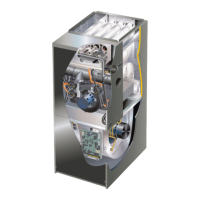NOTE - The flue collar on all models is sized to accommo-
date 2" Schedule 40 flue pipe, When vent pipe which is
larger than 2" must be used in an upflow application, a 2"
elbow must be applied at the flue collar in order to properly
transition to the larger diameter flue pipe. This elbow must
be added to the elbow count used to determine acceptable
vent lengths. Assign an equivalent feet value to this elbow.
Contact the Application Department for more information
concerning sizing of vent systems which include multiple
pipe sizes.
Use the following steps to correctly size vent pipe diameter,
Refer to Vent Pipe Size Determination Worksheet on
page 65.
1 - Determine the vent termination and its corresponding
equivalent feet value according to table 5,
2 - Determine the number of 90° elbows required for both
indoor and outdoor (e,g. snow riser) use. Calculate the
corresponding equivalent feet of vent pipe.
3 - Determine the number of 45° elbows required for both
indoor and outdoor use, Calculate the corresponding
equivalent feet of vent pipe,
4 - Determine the length of straight pipe required,
5- Add the total equivalent feet calculated in steps 1
through 4 and compare that length to the maximum
values given in table 7 for the proposed vent pipe di-
ameter. If more than one diameter of pipe is being
used, use the appropriate value from table 7 for the
larger sized pipe, If the total equivalent length required
exceeds the maximum equivalent length listed in the
appropriate table, evaluate the next larger size pipe.
AIMPORTANT
TABLE 6
MINIMUM VENT PIPE LENGTHS
G71MPP
MODEL
070,090
110"*
MIN. EQUIV.
VENT LENGTH
15 ft.*
135"**
*Any approved termination ma
length listed.
EXAMPLE
5 ft. plus 2 elbows of 2", 2-1/2", 3"
or 4" diameter pipe
5 ft. plus 2 elbows of 2-1/2" 3" or 4"
diameter pipe
5 ft, plus 2 elbows of 3" or 4"
diameter pipe
, be added to the minimum equivalent
**G71MPP-60C-110 must have 90 ° street eli (suppfied) installed directly
into unit flue collar.
***G71MPP-60D-135 must have 3" to 2" reducing eli (supplied) installed
directly into unit flue collar.
TABLE 7
MAXIMUM VENT PIPE LENGTHS
MAXIMUM EQUIVALENT VENT
G71MPP LENGTH FEET
ALTITUDE
MODEL 2" 2-1/2" 3" 4"
PIPE PIPE PiPE PiPE
070 75 135 150 250
0 - 7500 090 50 100 125 225
(0 - 2286 m) 110" 20 60 125 200
135"* n/a n/a 125 180
070 60 125 150 250
7501 - 10000 090 25 60 125 225
(2287 - 3048 m) 110" n/a 40 90 200
135"* n/a n/a 70 180
n/a -- Not allowed.
*G71MPP-60C-110 must have 90° street eli (supplied) installed directly
into unit flue collar.
**G71MPP-60D-135 must have 3" to 2" reducing eli (supplied) installed
directly into unit flue collar.
NOTE - Elbows and pipe required for vent terminations must be added
when calculating equivalent vent length.
All cementing of joints should be done according to the
specifications outlined in ASTM D 2855.
,& DANGER
1 - Measure and cut vent pipe to desired length,
2 - Debur and chamfer end of pipe, removing any ridges
or rough edges, If end is not chamfered, edge of pipe
may remove cement from fitting socket and result in a
leaking joint,
3 - Clean and dry surfaces to be joined,
4- Test fit joint and mark depth of fitting on outside of
pipe,
5 - Uniformly apply a liberal coat of PVC primer for PVC or
use a clean dry cloth for ABS to clean inside socket
surface of fitting and male end of pipe to depth of fitting
socket,
NOTE - Furnace flue collar and air inlet fitting are both
made of ABS material. Use transition solvent cement
when joining ABS fittings to PVC pipe,
6 - Promptly apply solvent cement to end of pipe and in-
side socket surface of fitting. Cement should be ap-
plied lightly but uniformly to inside of socket, Take care
to keep excess cement out of socket, Apply second
coat to end of pipe,
NOTE- Time is critical at this stage. Do not allow prim-
er to dry before applying cement.
Page 16

